Soil salinity is a serious global problem that threatens a high percentage of the global soils. Salinity stress can create ionic, oxidative, and osmotic stress, along with hormonal imbalances, in stressful plants. Application of nanomaterials for ameliorating salinity stress has gained great attention due to their high efficiency, eco-friendliness, and non-toxicity, especially biological nanomaterials. The application of nanomaterials (NMs) did not only support growing stressful plants under salinity stress but also increased the yield of crops, provided an economically feasible nutrient management approach, and was environmentally robust for sustainable crop productivity. Nano-management of salinity may involve applying traditional nano-amendments, biological nanomaterials, nano-enabled nutrients, nano-organic amendments, derived smart nanostructures, and nano-tolerant plant cultivars.
- nano-gypsum
- nanoparticles
- nanotoxicity nanofarming
- plant growth regulators
- salt stress
1. Introduction
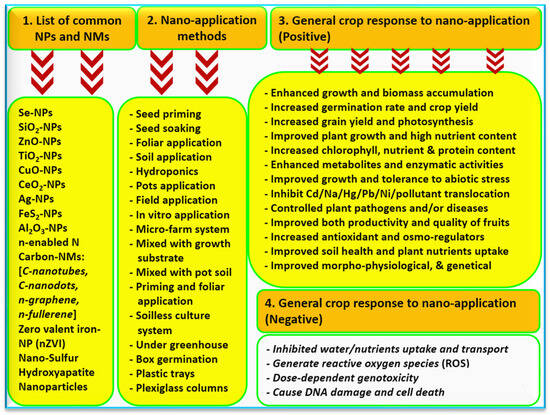
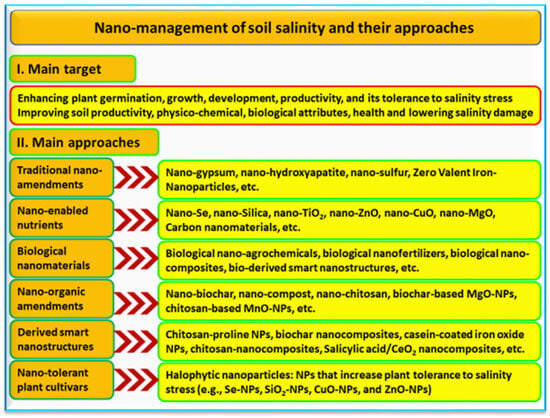
2. Nano-Management of Farming under Salinity Stress
2.1. Nano-Agrochemicals
Due to the incredible increase in global population and limited crop production, more than 800 million people are currently undernourished, and this will reach more than 2 billion people by 2050 [17]. In this situation, there is an urgent need to increase global agro-production by more than 70% in the next few decades, which requires more applications of agrochemicals (mainly fertilizers, pesticides, and plant growth regulators) for higher crop production to meet this global demand [18]. Every year, there is an over 2.5% increase in the global market of agrochemicals, which are directly linked to crop protection, as reported in 2017, to over 55 billion dollars [17]. These agrochemicals may be used for protecting cultivated crops from diseases (pesticides) or for increased crop production (chemical fertilizers). Several studies confirmed the potential of nano-based agrochemicals in agriculture (mainly in soil and plants) and the main factors controlling the fate and uptake of nano-agrochemicals by plants from soil (Figure 53). These studies focused on the toxicity of nano-based agrochemicals on non-target aquatic species [17], on plant-associated microbiomes [19], smart agrochemical nanomaterials [20][21], and their potential risk assessment for human health [22][23].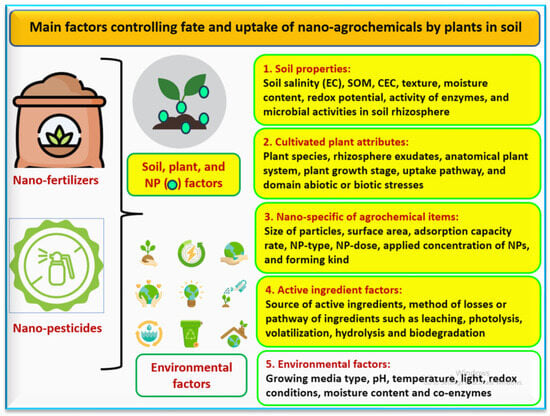
2.2. Nano-Soil Amendments
Why should we remediate saline soil? Soil salinization, or salinity, suffers from excessive accumulation of salts and degradation problems in soil (mainly decreased soil aeration, porosity, and water conductance due to the accumulation of Na+ in the soil). The main features of soil salinity may involve high values of soil EC (salinization), pH (alkalinization), and exchangeable sodium percent (ESP; sodification), which result from the high solubility of Na-salts and precipitation of CaCO3 under higher pH values [37]. The replacement of Na+ on the exchange sites by Ca+2 is the general amendment of soil salinity by applying chemical amendments (especially gypsum, calcium sulfate, or CaSO4·2H2O), organic amendments (biochar and chitosan), or nanomaterials (e.g., nano-gypsum, nano-sulfur, nano-biochar, and nano-chitosan). Therefore, according to soil values of pH, EC (dS m−1), sodium adsorption ratio (SAR), and ESP (%), there are four categories of salt-affected soils, including the previous parameters as follows: ±4, ±8.5, ±15, and ±13, respectively [38][39]. The main management strategies of soil salinity mitigation involve (1) removing excess salts from the soil profile by leaching and supplying enough water to prevent detrimental accumulated salts; (2) applying enough water for suitable methods of irrigation; (3) selecting the proper management of drainage and fertilization, as well as applying soil amendments like gypsum, sulfuric acid, elemental sulfur, or nanomaterials [40]. The suggested nano-managements have a crucial approach, which may depend on different mechanisms (Figure 64).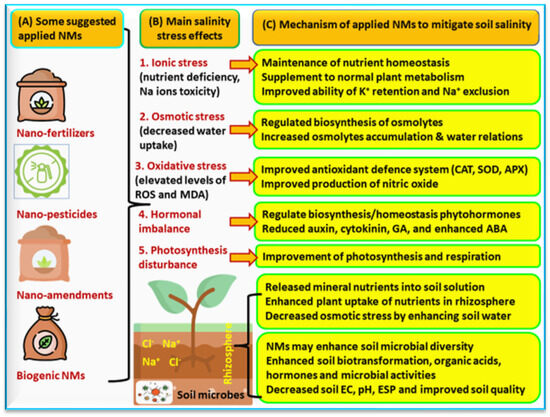
2.3. Biogenic Nanomaterials
What is the difference between biofertilizers and nanofertilizers? In brief, bio-fertilizers are certain microbial species (e.g., Azospirillum, Rhizobium, Cyanobacteria, Azolla, and solubilizer microbes) that can promote the potential of nutrients during the soil biogeochemical cycles, whereas nanofertilizers are fertilizers containing nanonutrients for increasing crop productivity [50]. This difference is critical in the case of biofertilizers and biological nano-fertilizers, where the last one means how to produce nanofertilizers by using biological methods with microorganisms or plants. Several reports confirmed the sustainable potential of biological nanofertilizers compared with physical or chemical ones [27][29][51]. Several factors control the effectively applied nanofertilizers, which mainly involve the production methods of nanofertilizers (physical, chemical, and biological ones), the applied dose, the physio-chemical properties of NPs, the application method (soil, foliar, hydroponics, etc.), the cultivated plant species, the experimental conditions, and the salinity stress level. Many studies have reported on plant growth regulators (PGRs) [52][53] and nanomaterials [54][55] for improving the productivity of crops under salinity stress. Under soil salinity stress, many studies reported the suggested mechanisms of PGRs by alleviating salinity stress in plants through enhancing accumulation of osmolytes in plant tissues (e.g., choline, glutamate, proline, glycine betaine, soluble sugars, and polyols), increasing antioxidant activities (e.g., ascorbate peroxidase, catalase, glutathione reductase, superoxide dismutase, monodehydroascorbate reductase, and peroxidase), and non-enzymatic antioxidants such as ascorbate, carotenoids, glutathione, polyphenols, and tocopherols [56][57]. Are biogenic nanomaterials important for sustainable agriculture? Why are these kinds of nanomaterials promising, especially under stressful conditions? It is well stated that bio-nanomaterials are an eco-friendly and economical alternative to soluble traditional agrochemicals due to their many benefits. These benefits may involve the low toxicity rate in the agroecosystem and the slow release of nutrients over the growing stage of the plant, which guarantee the continuous supply of nutrients (from bio-nanofertilizers) for higher crop quality and productivity while reducing many environmental risks [27]. These biological nano-agrochemicals will also not only promote crop production but will also contribute to food security, crop nutritional health, and environmental quality. The biological methods of nanomaterials include green and microbial methods (Figure 75).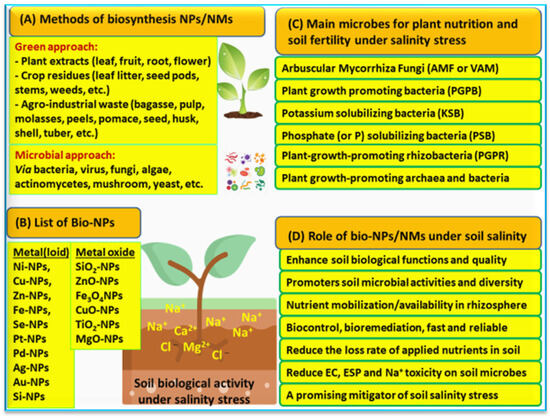
2.4. Nanocomposites
What are nanocomposites? Why are these composites vital as agrochemicals for crop production and environmental production? Nanocomposites are special materials formed from different materials to enhance their final properties, including mechanical, thermal, optical, biodegradability, and barrier properties. Nanocomposites are promising promoters for sustainable and eco-friendly cultivation, reducing the burden of mineral fertilizers and pesticides [63]. Nanocomposites have several benefits in the agriculture, food, and medicinal sectors. In agriculture, several nanocomposites have been developed for nutrient management [64], soil and water remediation [65], food packaging [66], environmental protection [67], and supporting plants under salinity stress [68]. The mode of action of nanocomposites mainly depends on the kinds of nanocomposites, their active components, their applied dose, and the environmental conditions. Several studies were reported on different types of nanocomposites, such as curcumin-polyvinyl alcohol nanocomposites [69], biochar nanocomposites [70][71], casein-coated iron oxide NPs [64], and chitosan nanocomposites [72][73]. Treatments with nanocomposites of chitosan or biochar are common under salinity stress and are applied at low doses, which are able to mitigate osmotic stress under the cultivation of different crops, such as dill [71], safflower [70], grape [74], and wheat [72][73]. Nano-chitosan can support previous crops due to being non-toxic, having greater adsorption ability, having a higher surface area, and having a higher ability to encapsulate with other active molecules with high encapsulation efficiency compared to the control [75]. These results were confirmed under pot conditions and under different controlled saline soils. There are many advantages to biological nanocomposites, such as biodegradability as eco-friendly biopolymers, improved characteristics, and a lower carbon footprint due to lower emissions of greenhouse gases [76]. Biopolymer-based nanocomposites are effective candidates for controlling and slowing the release of different agrochemical formulations due to their features. They may involve high-effective carriers of core ingredients precisely to the plants, lowering environmental pollution risks, and apply agrochemical amounts due to less frequent applications. They are also safe to use, reduce environmental impacts, enhance water retention properties, and are designed to target specific sites of weeds or pests [76].2.5. In Vitro Nano-Management
The study of applied nanomaterials under saline conditions can be performed even under in vitro conditions. Nano-plant tissue culture means the study of certain plant species grown on sterile nutrient medium supplemented with nanoparticles under fully controlled conditions. This kind of study is crucial nano-management for many in vitro plant biology studies, such as embryogenesis, cytology, pathology, morphogenesis, and clonal propagation [6]. The successful growth and development of in vitro plants depends on factors related to the type of explants, the genotype, the culture medium, methods of surface disinfection, the intensity of light, temperature regimes, and growth regulators. There is a positive impact of applied nanoparticles on plant tissue culture; for example, they can improve the germination of seeds, enhance plant growth, stimulate the production of bioactive compounds, and protect plants under salinity stress. At different salinity levels, many kinds of nanoparticles were used in vitro for improving plant growth under such stress, including metal NPs or nanocomposite. Plant tissue culture is considered an economically applicable technique for producing grape softwood cuttings [77] or strawberry explants/transplants [78] or mitigating salt stress on plants such as coriander [79], banana [80], and tomato [55]. The applied nanomaterials included a variety of nanoforms, such as metal/metalloid NPs or nanocomposites. Different types of nanocomposites were investigated in vitro under salinity stress, such as proline-doped ZnO nanocomposites [79] and ZnO-glycine betaine nanocomposites [81].3. Nano-Management under Toxicity Conditions
Despite the previous potential benefits of nanomaterials, many reports pointed out the expected harmful effects of intensive applications of such NMs in agroecosystem compartments as nanotoxicity [82][83][84]. These compartments may involve the nanotoxicity of the soil rhizosphere, aquatic life, cultivated plants, soil organisms, farm animals, groundwater, drinking water, the food chain, and humans. However, there are still significant gaps in research and a lack of rigorous monitoring of this nanotoxicity [59]. This toxicity has many levels that are needed to be investigated, such as phytotoxicity, cytotoxicity, and genotoxicity (Figure 86). Higher doses of NMs may cause cytotoxicity and genotoxicity for living organisms (plants and microbes) through damage to DNA structure, a reduction in the viability of cells, an alteration in genes, aberrations in chromosomes, and a reduction in the mitotic index [85]. The phytotoxicity study of engineered NPs is an emerging concern to elucidate their potential effects on plant systems [86]. This phytotoxicity is known to be totally controlled by the chemical nature of the element (NP), surface charge, size, coating molecules, and environmental factors like pH and light [83]. The toxic level of applied nanomaterials or nanoparticles on cultivated plants was reported. This toxic level mainly depends on the plant species, applied dose and type of NPs, size of applied NPs, cultivation method or growing medium, method of application, etc. It was found that applying nano-zero-valent iron (nZVI) caused toxicity to mung bean under hydroponically cultured seedlings at 600 mg L−1 [87], whereas applying more than 200 mg L−1 nZVI to Herbaceous cattail exhibited strong toxic effects [88]. Depending on the type of NPs and plant species, it was noticed that the toxic level of Fe-based NPs may range from 50 to 2000 mg L−1 [89].
References
- Seleiman, M.F.; Almutairi, K.F.; Alotaibi, M.; Shami, A.; Alhammad, B.A.; Battaglia, M.L. Nano-Fertilization as an Emerging Fertilization Technique: Why Can Modern Agriculture Benefit from Its Use? Plants 2021, 10, 2.
- hardwaj, A.K.; Arya, G.; Kumar, R.; Hamed, L.; Pirasteh-Anosheh, H.; Jasrotia, P.; Kashyap, P.L.; Singh, G.P. Switching to nanonutrients for sustaining agroecosystems and environment: The challenges and benefits in moving up from ionic to particle feeding. J. Nanobiotechnology 2022, 20, 19.
- Gangwar, J.; Sebastian, J.K.; Jaison, J.P.; Kurian, J.T. Nano-technological interventions in crop production—A review. Physiol. Mol. Biol. Plants 2023, 29, 93–107.
- Konappa, N.; Krishnamurthy, S.; Arakere, U.C.; Chowdappa, S.; Akbarbasha, R.; Ramachandrappa, N.S. Nanofertilizers and nanopesticides: Recent trends, future prospects in agriculture. In Advances in Nano-Fertilizers and Nano-Pesticides in Agriculture; Elsevier: Amsterdam, The Netherlands, 2021; pp. 281–330.
- El-Ramady, H.; Abdalla, N.; Sári, D.; Ferroudj, A.; Muthu, A.; Prokisch, J.; Fawzy, Z.F.; Brevik, E.C.; Solberg, S.Ø. Nanofarming: Promising Solutions for the Future of the Global Agricultural Industry. Agronomy 2023, 13, 1600.
- Munir, N.; Hanif, M.; Dias, D.A.; Abideen, Z. The role of halophytic nanoparticles towards the remediation of degraded and saline agricultural lands. Environ. Sci. Pollut. Res. Int. 2021, 28, 60383–60405.
- Sahab, S.; Suhani, I.; Srivastava, V.; Chauhan, P.S.; Singh, R.P.; Prasad, V. Potential risk assessment of soil salinity to agroecosystem sustainability: Current status and management strategies. Sci. Total Environ. 2021, 764, 144164.
- Navarro-Torre, S.; Aguilera-Salas, M.; Ávila-Pozo, P.; Parrado, J.; Tejada, M. Study of the biochemical activity and plant growth promoting bacteria in soils polluted with oxyfluorfen. Cogent Food Agric. 2023, 9, 2247171.
- Alhammad, B.A.; Abdel-Aziz, H.M.M.; Seleiman, M.F.; Tourky, S.M.N. How Can Biological and Chemical Silver Nanoparticles Positively Impact Physio-Chemical and Chloroplast Ultrastructural Characteristics of Vicia faba Seedlings? Plants 2023, 12, 2509.
- Alhammad, B.A.; Ahmad, A.; Seleiman, M.F. Nano-Hydroxyapatite and ZnO-NPs Mitigate Pb Stress in Maize. Agronomy 2023, 13, 1174.
- Al-Selwey, W.A.; Alsadon, A.A.; Alenazi, M.M.; Tarroum, M.; Ibrahim, A.A.; Ahmad, A.; Osman, M.; Seleiman, M.F. Morphological and Biochemical Response of Potatoes to Exogenous Application of ZnO and SiO2 Nanoparticles in a Water Deficit Environment. Horticulturae 2023, 9, 883.
- Ahmad, A.; Tola, E.; Alshahrani, T.S.; Seleiman, M.F. Enhancement of Morphological and Physiological Performance of Zea mays L. under Saline Stress Using ZnO Nanoparticles and 24-Epibrassinolide Seed Priming. Agronomy 2023, 13, 771.
- Shafiq, F.; Iqbal, M.; Raza, S.H.; Akram, N.A.; Ashraf, M. Fullerenol Nano-cages for Protection of Crops Against Oxidative Stress: A Critical Review. J. Plant Growth Regul. 2023, 42, 1267–1290.
- Baazaoui, N.; Bellili, K.; Messaoud, M.; Elleuch, L.; Elleuch, R.; Labidi, S.; Aounallah, K.; Maazoun, A.; Salhi, R.; Shati, A.A.; et al. Bio-nano-remediation of Olive Oil Mill Wastewater using Silicon Dioxide Nanoparticles for Its Potential Use as Biofertilizer for Young Olive Plants. Silicon 2023, 1–17.
- El-Saadony, M.T.; Desoky, E.M.; Saad, A.M.; Eid, R.S.M.; Selem, E.; Elrys, A.S. Biological silicon nanoparticles improve Phaseolus vulgaris L. yield and minimize its contaminant contents on a heavy metals-contaminated saline soil. J. Environ. Sci. 2021, 106, 1–14.
- Ghazi, A.A.; El-Nahrawy, S.; El-Ramady, H.; Ling, W. Biosynthesis of Nano-Selenium and Its Impact on Germination of Wheat under Salt Stress for Sustainable Production. Sustainability 2022, 14, 1784.
- Zhang, Y.; Goss, G.G. Nanotechnology in agriculture: Comparison of the toxicity between conventional and nano-based agrochemicals on non-target aquatic species. J. Hazard. Mater. 2022, 439, 129559.
- Grillo, R.; Fraceto, L.F.; Amorim, M.J.B.; Scott-Fordsmand, J.J.; Schoonjans, R.; Chaudhry, Q. Ecotoxicological and regulatory aspects of environmental sustainability of nanopesticides. J. Hazard. Mater. 2021, 404 Pt A, 124148.
- Ahmed, T.; Noman, M.; Gardea-Torresdey, J.L.; White, J.C.; Li, B. Dynamic interplay between nano-enabled agrochemicals and the plant-associated microbiome. Trend Plant Sci. 2023.
- Sharma, S.; Kumar, A.; Choudhary, A.; Harish, B.M.; Karmakar, P.; Sharma, P.; Singh, J.; Pandey, V.; Mehta, S. Recent developments in smart nano-agrochemicals: A promise for revolutionizing present-day agriculture. Mater. Today Proc. 2022, 69 Pt 2, 530–534.
- He, J.; Li, J.; Gao, Y.; He, X.; Hao, G. Nano-based smart formulations: A potential solution to the hazardous effects of pesticide on the environment. J. Hazard. Mater. 2023, 456, 131599.
- Aiad, M.A.; Amer, M.M.; Khalifa, T.H.H.; Shabana, M.M.A.; Zoghdan, M.G.; Shaker, E.M.; Eid, M.S.M.; Ammar, K.A.; Al-Dhumri, S.A.; Kheir, A.M.S. Combined Application of Compost, Zeolite and a Raised Bed Planting Method Alleviate Salinity Stress and Improve Cereal Crop Productivity in Arid Regions. Agronomy 2021, 11, 2495.
- Okeke, E.S.; Ezeorba, T.P.C.; Mao, G.; Chen, Y.; Feng, W.; Wu, X. Nano-enabled agrochemicals/materials: Potential human health impact, risk assessment, management strategies and future prospects. Environ. Pollut. 2022, 295, 118722.
- Rani, N.; Duhan, A.; Pal, A.; Kumari, P.; Beniwal, R.K.; Verma, D.; Goyat, A.; Singh, R. Are nano-pesticides really meant for cleaner production? An overview on recent developments, benefits, environmental hazards and future prospectives. J. Clean. Prod. 2023, 411, 137232.
- Yin, J.; Su, X.; Yan, S.; Shen, J. Multifunctional Nanoparticles and Nanopesticides in Agricultural Application. Nanomaterials 2023, 13, 1255.
- Shen, M.; Liu, S.; Jiang, C.; Zhang, T.; Chen, W. Recent advances in stimuli-response mechanisms of nano-enabled controlled-release fertilizers and pesticides. Eco-Env. Health 2023, 2, 161–175.
- Jha, A.; Pathania, D.; Sonu, D.B.; Raizada, P.; Rustagi, S.; Singh, P.; Rani, G.M.; Chaudhary, V. Panorama of biogenic nano-fertilizers: A road to sustainable agriculture. Environ. Res. 2023, 235, 116456.
- Guo, H.; White, J.C.; Wang, Z.; Xing, B. Nano-enabled fertilizers to control the release and use efficiency of nutrients. Curr. Opin. Environ. Sci. Health 2018, 6, 77–83.
- Yadav, A.; Yadav, K.; Abd-Elsalam, K.A. Nanofertilizers: Types, Delivery and Advantages in Agricultural Sustainability. Agrochemicals 2023, 2, 296–336.
- Muhammad, H.M.D.; Abbas, A.; Ahmad, R. Fascinating Role of Silicon Nanoparticles to Mitigate Adverse Effects of Salinity in Fruit Trees: A Mechanistic Approach. Silicon 2022, 14, 8319–8326.
- El-Badri, A.M.; Hashem, A.M.; Batool, M.; Sherif, A.; Nishawy, E.; Ayaad, M.; Hassan, H.M.; Elrewainy, I.M.; Wang, J.; Kuai, J.; et al. Comparative efficacy of bio-selenium nanoparticles and sodium selenite on morpho-physiochemical attributes under normal and salt stress conditions, besides selenium detoxification pathways in Brassica napus L. J. Nanobiotechnology 2022, 20, 163.
- Song, Y.; Zheng, C.; Li, S.; Chen, J.; Jiang, M. Chitosan-Magnesium Oxide Nanoparticles Improve Salinity Tolerance in Rice (Oryza sativa L.). ACS Appl. Mater. Interfaces 2023, 15, 20649–20660.
- Ding, Z.; Zhao, F.; Zhu, Z.; Ali, E.F.; Shaheen, S.M.; Rinklebe, J.; Eissa, M.A. Green nanosilica enhanced the salt-tolerance defenses and yield of Williams banana: A field trial for using saline water in low fertile arid soil. Environ. Exp. Bot. 2022, 197, 104843.
- Abdalla, H.; Adarosy, M.H.; Hegazy, H.S.; Abdelhameed, R.E. Potential of green synthesized titanium dioxide nanoparticles for enhancing seedling emergence, vigor and tolerance indices and DPPH free radical scavenging in two varieties of soybean under salinity stress. BMC Plant Biol. 2022, 22, 560.
- Sarkar, R.D.; Kalita, M.C. Se nanoparticles stabilized with Allamanda cathartica L. flower extract inhibited phytopathogens and promoted mustard growth under salt stress. Heliyon 2022, 8, e09076.
- Shelar, A.; Nile, S.H.; Singh, A.V.; Rothenstein, D.; Bill, J.; Xiao, J.; Chaskar, M.; Kai, G.; Patil, R. Recent Advances in Nano-Enabled Seed Treatment Strategies for Sustainable Agriculture: Challenges, Risk Assessment, and Future Perspectives. Nano-Micro Lett. 2023, 15, 54.
- Patle, T.; Sharma, S.K. Synthesis of nano-gypsum: A computational approach to encounter soil salinity and land degradation. Comput. Theor. Chem. 2022, 1217, 113909.
- Arora, S. Diagnostic Properties and Constraints of Salt-Affected Soils. In Bioremediation of Salt Affected Soils: An Indian Perspective; Springer International Publishing AG: Berlin/Heidelberg, Germany, 2017.
- Arora, S.; Singh, A.K.; Singh, Y.P. Bioremediation of Salt Affected Soils: An Indian Perspective; Springer-International Publishing AG: Berlin/Heidelberg, Germany, 2017.
- El-Ramady, H.; Abowaly, M.; Elbehiry, F.; Omara, A.E.-D.; Elsakhawy, T.; Mohamed, E.S.; Belal, A.; Elbasiouny, H.; Fawzy, Z.F. Stressful Environments and Sustainable Soil Management: A Case Study of Kafr El-Sheikh, Egypt. Environ. Biodiv. Soil Secur. 2019, 3, 193–213.
- Salama, A.M.; El-Halim, A.E.-H.A.A.; Ibrahim, M.M.; Aiad, M.A.; El-Shal, R.M. Amendment with Nanoparticulate Gypsum Enhances Spinach Growth in Saline-Sodic Soil. J. Soil Sci. Plant Nutr. 2022, 22, 3377–3385.
- Balusamy, S.R.; Rahimi, S.; Sukweenadhi, J.; Sunderraj, S.; Shanmugam, R.; Thangavelu, L.; Mijakovic, I.; Perumalsamy, H. Chitosan, chitosan nanoparticles and modified chitosan biomaterials, a potential tool to combat salinity stress in plants. Carbohydr. Polym. 2022, 284, 119189.
- Hidangmayum, A.; Dwivedi, P. Chitosan Based Nanoformulation for Sustainable Agriculture with Special Reference to Abiotic Stress: A Review. J. Polym. Environ. 2022, 30, 1264–1283.
- Hoque, M.N.; Imran, S.; Hannan, A.; Paul, N.C.; Mahamud, M.A.; Chakrobortty, J.; Sarker, P.; Irin, I.J.; Brestic, M.; Rhaman, M.S. Organic Amendments for Mitigation of Salinity Stress in Plants: A Review. Life 2022, 12, 1632.
- Giannelli, G.; Potestio, S.; Visioli, G. The Contribution of PGPR in Salt Stress Tolerance in Crops: Unravelling the Molecular Mechanisms of Cross-Talk between Plant and Bacteria. Plants 2023, 12, 2197.
- Duan, M.; Yan, R.; Wang, Q.; Zhou, B.; Zhu, H.; Liu, G.; Guo, X.; Zhang, Z. Integrated microbiological and metabolomics analyses to understand the mechanism that allows modified biochar to affect the alkalinity of saline soil and winter wheat growth. Sci. Total Environ. 2023, 866, 161330.
- Rajput, V.D.; Minkina, T.; Ahmed, B.; Singh, V.K.; Mandzhieva, S.; Sushkova, S.; Bauer, T.; Verma, K.K.; Shan, S.; van Hullebusch, E.D.; et al. Nano-biochar: A novel solution for sustainable agriculture and environmental remediation. Environ. Res. 2022, 210, 112891.
- Li, Z.; Zhu, L.; Zhao, F.; Li, J.; Zhang, X.; Kong, X.; Wu, H.; Zhang, Z. Plant Salinity Stress Response and Nano-Enabled Plant Salt Tolerance. Front. Plant Sci. 2022, 13, 843994.
- Wu, Y.; Wang, X.; Zhang, L.; Zheng, Y.; Liu, X.; Zhang, Y. The critical role of biochar to mitigate the adverse impacts of drought and salinity stress in plants. Front. Plant Sci. 2023, 14, 1163451.
- El-Ghamry, A.M.; Mosa, A.A.; Alshaal, T.A.; ElRamady, H.R. Nanofertilizers vs. Biofertilizers: New Insights. Environ. Biodiv. Soil Secur. 2018, 2, 51–72.
- Shalaby, T.A.; Bayoumi, Y.; Eid, Y.; Elbasiouny, H.; Elbehiry, F.; Prokisch, J.; El-Ramady, H.; Ling, W. Can Nanofertilizers Mitigate Multiple Environmental Stresses for Higher Crop Productivity? Sustainability 2022, 14, 3480.
- Abdel-Rahman, H.M.; Zaghloul, R.A.; Enas, A.; Hassan, H.R.A.; El-Zehery, A.A.; Salem, A.A. New Strains of Plant Growth-Promoting Rhizobacteria in Combinations with Humic Acid to Enhance Squash Growth under Saline Stress. Egypt. J. Soil. Sci. 2021, 61, 129–146.
- Neshat, M.; Abbasi, A.; Hosseinzadeh, A.; Sarikhani, M.R.; Chavan, D.D.; Rasoulnia, A. Plant growth promoting bacteria (PGPR) induce antioxidant tolerance against salinity stress through biochemical and physiological mechanisms. Physiol. Mol. Biol. Plants 2022, 28, 347–361.
- Abd-Elzaher, M.A.; El-Desoky, M.A.; Khalil, F.A.; Eissa, M.E.; Amin, A.E.A. Interactive Effects of K-Humate, Proline and Si and Zn Nanoparticles in Improving Salt Tolerance of Wheat in Arid Degraded Soils. Egypt. J. Soil Sci. 2022, 62, 237–251.
- Aazami, M.A.; Rasouli, F.; Ebrahimzadeh, A. Oxidative damage, antioxidant mechanism and gene expression in tomato responding to salinity stress under in vitro conditions and application of iron and zinc oxide nanoparticles on callus induction and plant regeneration. BMC Plant Biol. 2021, 21, 597.
- Ha-Tran, D.M.; Nguyen, T.T.M.; Hung, S.H.; Huang, E.; Huang, C.C. Roles of Plant Growth-Promoting Rhizobacteria (PGPR) in Stimulating Salinity Stress Defense in Plants: A Review. Int. J. Mol. Sci. 2021, 22, 3154.
- Shultana, R.; Zuan, A.T.K.; Naher, U.A.; Islam, A.K.M.M.; Rana, M.M.; Rashid, M.H.; Irin, I.J.; Islam, S.S.; Rim, A.A.; Hasan, A.K. The PGPR Mechanisms of Salt Stress Adaptation and Plant Growth Promotion. Agronomy 2022, 12, 2266.
- Sambangi, P.; Gopalakrishnan, S.; Pebam, M.; Rengan, A.K. Nano-biofertilizers on soil health, chemistry, and microbial community: Benefits and risks. Proc. Indian Natl. Sci. Acad. 2022, 88, 357–368.
- Chaudhary, V.; Rustagi, S.; Kaushik, A. Bio-derived smart nanostructures for efficient biosensors. Curr. Opin. Green Sustain. Chem. 2023, 42, 100817.
- Tolisano, C.; Del Buono, D. Biobased: Biostimulants and biogenic nanoparticles enter the scene. Sci. Total Environ. 2023, 885, 163912.
- Dhlamini, B.; Paumo, H.K.; Kamdem, B.P.; Katata-Seru, L.; Bahadur, I. Nano-engineering metal-based fertilizers using biopolymers: An innovative strategy for a more sustainable agriculture. J. Environ. Chem. Eng. 2022, 10, 107729.
- Sharma, B.; Tiwari, S.; Kumawat, K.C.; Cardinale, M. Nano-biofertilizers as bio-emerging strategies for sustainable agriculture development: Potentiality and their limitations. Sci. Total Environ. 2023, 860, 160476.
- Chakraborty, R.; Mukhopadhyay, A.; Paul, S.; Sarkar, S.; Mukhopadhyay, R. Nanocomposite-based smart fertilizers: A boon to agricultural and environmental sustainability. Sci. Total. Environ. 2023, 863, 160859.
- Burvey, P.; Jain, P.; Singh, A. Strategic role of casein coated iron oxide nano-particles for delivering nano nutrients for enhance soil quality and their potential. Mater. Today Proc. 2023, 89, 96–105.
- Mirzaee, E.; Sartaj, M. Remediation of PAH-contaminated soil using a combined process of soil washing and adsorption by nano iron oxide/granular activated carbon composite. Environ. Nanotechnol. Monit. Manag. 2023, 20, 100800.
- Wypij, M.; Trzcińska-Wencel, J.; Golińska, P.; Avila-Quezada, G.D.; Ingle, A.P.; Rai, M. The strategic applications of natural polymer nanocomposites in food packaging and agriculture: Chances, challenges, and consumers’ perception. Front. Chem. 2023, 10, 1106230.
- Yang, J.; Han, X.; Yang, W.; Hu, J.; Zhang, C.; Liu, K.; Jiang, S. Nanocellulose-based composite aerogels toward the environmental protection: Preparation, modification and applications. Environ. Res. 2023, 236 Pt 1, 116736.
- Haydar, S.; Ali, S.; Mandal, P.; Roy, D.; Roy, M.N.; Kundu, S.; Kundu, S.; Choudhuri, C. Fe–Mn nanocomposites doped graphene quantum dots alleviate salt stress of Triticum aestivum through osmolyte accumulation and antioxidant defense. Sci. Rep. 2023, 13, 11040.
- Zaki, F.S.; Khater, M.A.; El-Awadi, M.E.; Dawood, M.G.; Elsayed, A.E. Curcumin-polyvinyl alcohol nano-composite enhances tolerance of Helianthus annuus L. against salinity stress. Beni-Suef Univ. J. Basic Appl. Sci. 2023, 12, 60.
- Farhangi-Abriz, S.; Ghassemi-Golezani, K. Changes in soil properties and salt tolerance of safflower in response to biochar-based metal oxide nanocomposites of magnesium and manganese. Ecotoxicol. Environ. Safety 2021, 211, 111904.
- Rahimzadeh, S.; Ghassemi-Golezani, K. Biochar-Based Nutritional Nanocomposites Altered Nutrient Uptake and Vacuolar H+-Pump Activities of Dill Under Salinity. J. Soil Sci. Plant Nutr. 2022, 22, 3568–3581.
- Hajihashemi, S.; Kazemi, S. The potential of foliar application of nano-chitosan-encapsulated nano-silicon donor in amelioration the adverse effect of salinity in the wheat plant. BMC Plant Biol. 2022, 22, 148.
- Al Hinai, M.S.; Ullah, A.; Al-Toubi, A.-K.M.; Al Harrasi, I.R.; Alamri, A.A.; Farooq, M. Co-application of Biochar and Seed Priming with Nano-sized Chitosan-Proline Improves Salt Tolerance in Differentially Responding Bread Wheat Genotypes. J. Soil Sci. Plant Nutr. 2023, 23, 1–16.
- Aazami, M.A.; Maleki, M.; Rasouli, F.; Gohari, G. Protective effects of chitosan based salicylic acid nanocomposite (CS-SA NCs) in grape (Vitis vinifera cv. ‘Sultana’) under salinity stress. Sci. Rep. 2023, 13, 883.
- Ingle, P.U.; Shende, S.S.; Shingote, P.R.; Mishra, S.S.; Sarda, V.; Wasule, D.L.; Rajput, V.D.; Minkina, T.; Rai, M.; Sushkova, S.; et al. Chitosan nanoparticles (ChNPs): A versatile growth promoter in modern agricultural production. Heliyon 2022, 8, e11893.
- Mohan, M.F.; Praseetha, P.N. Prospects of Biopolymers Based Nanocomposites for the Slow and Controlled Release of Agrochemicals Formulations. J. Inorg. Organomet. Polym. 2023, 1–16.
- Mozafari, A.; Ghadakchi asl, A.; Ghaderi, N. Grape response to salinity stress and role of iron nanoparticle and potassium silicate to mitigate salt induced damage under in vitro conditions. Physiol. Mol. Biol. Plants 2018, 24, 25–35.
- Mozafari, A.; Dedejani, S.; Ghaderi, N. Positive responses of strawberry (Fragaria × ananassa Duch.) explants to salicylic and iron nanoparticle application under salinity conditions. Plant Cell Tissue Organ Cult. 2018, 134, 267–275.
- Hanif, S.; Sajjad, A.; Javed, R.; Mannan, A.; Zia, M. Proline doped ZnO nanocomposite alleviates NaCl induced adverse effects on morpho-biochemical response in Coriandrum sativum. Plant Stress 2023, 9, 100173.
- Mahmoud, E.; El Baroudy, A.; Ali, N.; Sleem, M. Spectroscopic studies on the phosphorus adsorption in salt-affected soils with or without nano-biochar additions. Environ. Res. 2020, 184, 109277.
- Hanif, S.; Zia, M. Glycine betaine capped ZnO NPs eliminate oxidative stress to coriander plants grown under NaCl presence. Plant Physiol. Biochem. 2023, 197, 107651.
- Murali, M.; Gowtham, H.G.; Brijesh, S.; Shilpa, S.N.; Aiyaz, M.; Alomary, M.N.; Alshamrani, M.; Salawi, A.; Almoshari, Y.; Ansari, M.A.; et al. Fate, bioaccumulation and toxicity of engineered nanomaterials in plants: Current challenges and future prospects. Sci. Total Environ. 2022, 811, 152249.
- Mathur, P.; Chakraborty, R.; Aftab, T.; Roy, S. Engineered nanoparticles in plant growth: Phytotoxicity concerns and the strategies for their attenuation. Plant Physiol. Biochem. 2023, 199, 107721.
- Oliveira, H.C.; Seabra, A.B.; Kondak, S.; Adedokun, O.P.; Kolbert, Z. Multilevel approach to plant–nanomaterial relationships: From cells to living ecosystems. J. Exper. Bot. 2023, 74, 3406–3424.
- Chanu, N.B.; Alice, A.K.; Thokchom, A.; Singh, M.C.; Chanu, N.T.; Singh, Y.D. Engineered nanomaterial and their interactions with plant–soil system: A developmental journey and opposing facts. Nanotechnol. Environ. Eng. 2021, 6, 36.
- Sukul, U.; Das, K.; Chen, J.S.; Sharma, R.K.; Dey, G.; Banerjee, P.; Taharia, M.; Lee, C.-I.; Maity, J.P.; Lin, P.Y.; et al. Insight interactions of engineered nanoparticles with aquatic higher plants for phytoaccumulation, phytotoxicity, and phytoremediation applications: A review. Aquat. Toxicol. 2023, 264, 106713.
- Sun, Y.; Jing, R.; Zheng, F.; Zhang, S.; Jiao, W.; Wang, F. Evaluating phytotoxicity of bare and starch-stabilized zero-valent iron nanoparticles in mung bean. Chemosphere 2019, 236, 124336.
- Ma, X.; Gurung, A.; Deng, Y. Phytotoxicity and uptake of nanoscale zero-valent iron (nZVI) by two plant species. Sci. Total Environ. 2013, 443, 844–849.
- Shakoor, N.; Adeel, M.; Nadeem, M.; Abdullah Aziz, M.; Zain, M.; Hussain, M.; Azeem, I.; Xu, M.; Ahmad, M.A.; Rui, Y. Exploring the Effects of Iron Nanoparticles on Plants: Growth, Phytotoxicity, and Defense Mechanisms. In Nanomaterials and Nanocomposites Exposures to Plants, Smart Nanomaterials Technology; Husen, A., Ed.; Springer Nature: Singapore, 2023; pp. 209–226.
- Shah, G.M.; Amin, M.; Shahid, M.; Ahmad, I.; Khalid, S.; Abbas, G.; Imran, M.; Naeem, M.A.; Shahid, N. Toxicity of ZnO and Fe2O3 nano-agro-chemicals to soil microbial activities, nitrogen utilization, and associated human health risks. Environ. Sci. Eur. 2022, 34, 106.
- Jam, B.J.; Shekari, F.; Andalibi, B.; Fotovat, R.; Jafarian, V.; Dolatabadian, A. The Effects of Salicylic Acid and Silicon on Safflower Seed Yield, Oil Content, and Fatty Acids Composition under Salinity Stress. Silicon 2023, 15, 4081–4094.
- Singh, P.; Arif, Y.; Siddiqui, H.; Sami, F.; Zaidi, R.; Azam, A.; Alam, P.; Hayat, S. Nanoparticles enhances the salinity toxicity tolerance in Linum usitatissimum L. by modulating the antioxidative enzymes, photosynthetic efficiency, redox status and cellular damage. Ecotoxicol. Environ. Saf. 2021, 213, 112020.
